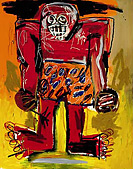

 Royalty, heroes and the streets Two major paintings embody Basquiat's central themes 'Royalty, heroes and the streets' (Basquiat, quoted in H. Geldzahler, 'Art: from Subways to Soho: Jean Michel Basquiat', pp. 18-26, Jean Michel Basquiat: Gemälde und Arbeiten auf Papier, exh.cat.,Vienna, 1999, p. 23). These were the themes that Basquiat stated lay at the centre of his art, and they are all clearly present in Untitled (Black Figure) and Sugar Ray Robinson. Both painted in 1982, the year that Basquiat claimed he created his 'best paintings ever', these pictures combine the artist's expressive, expressionistic brushwork, a legacy from his days as one half of the graffiti partnership SAMO only a couple of years earlier, with vividly scrawled figures from his unique pantheon of black heroes. These black heroes, be they named or anonymous, always feature a degree of self-portraiture; they are substitutes for Basquiat who is elated by their successes and shares their trials and turmoils. In Untitled (Black Figure), the man is a stand-in for the artist as he looks over a scene of strange urban chaos. The raw and pulsing energy of Basquiat's paintings, derived from the street and from his street paintings, is brought to the fore in this picture: its scale resembles that of a ramshackle wall. Basquiat has scrawled innumerable arcane symbols across this textured, highly-worked surface, giving the sense of a wall transposed directly from some gritty urban environment. This 'wall' is filled with ominous writings, like the product of a madman. Numbers, words, games, shapes, scales, all combine to create an atmosphere that is made all the more unfamiliar by being so close to the familiar, as though written out in some frantic code. The black figure watches over this scene, which is spread before him, and above his head is a vast encircling halo, marking him out as a hero looking out upon the chaos of contemporary city existence. Sugar Ray Robinson shows the eponymous boxer presented as a vividly scrawled totem, a new god for a more secular, urban age, filled with his own energy as well as the energy of the painter's own exertions. Robinson was a hero, an idol for a young African-American struggling in a white-dominated world, admired as the greatest boxer even by Muhammad Ali. And yet, in a reflection of Basquiat's own anxieties about the precariousness of his success as an artist in the conservative art world and prefiguring his own eventual demise, Sugar Ray Robinson is also presented as a martyr - he would become the victim of his own success, spending far too much, seduced by the highlife, frittering away millions of dollars on a fabled thousand suits and a constant entourage of beautiful female admirers. Sugar Ray Robinson captures the artist's admiration - and his anxiety. The electric, hunched figure of the boxer is defiant yet embattled, looming, yet with the weight of the world on his shoulders like a modern-day Atlas. Article provided by Christie's Post-War & Contemporary Art Department, New York |